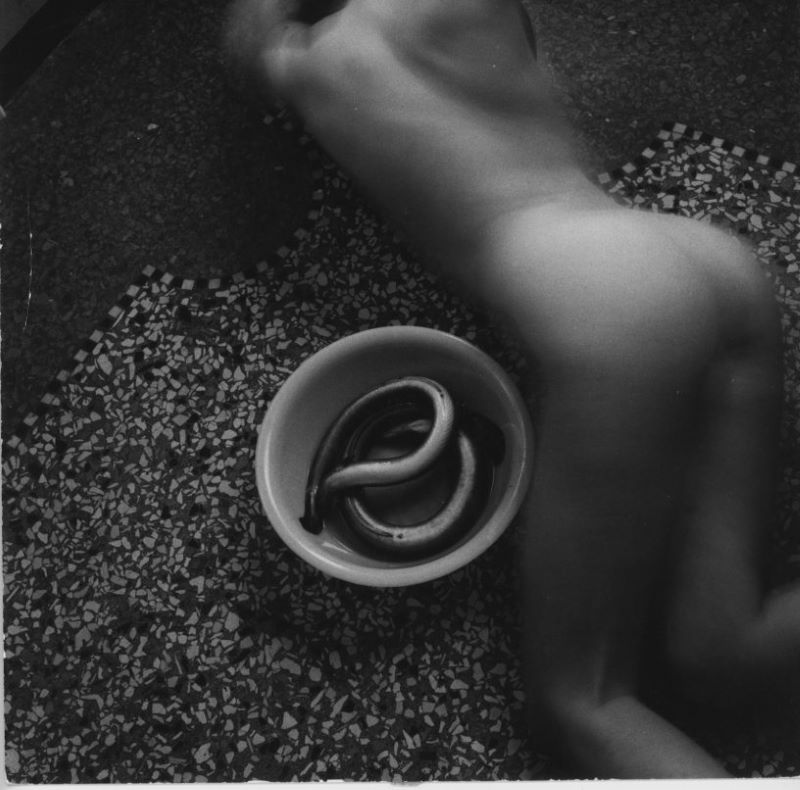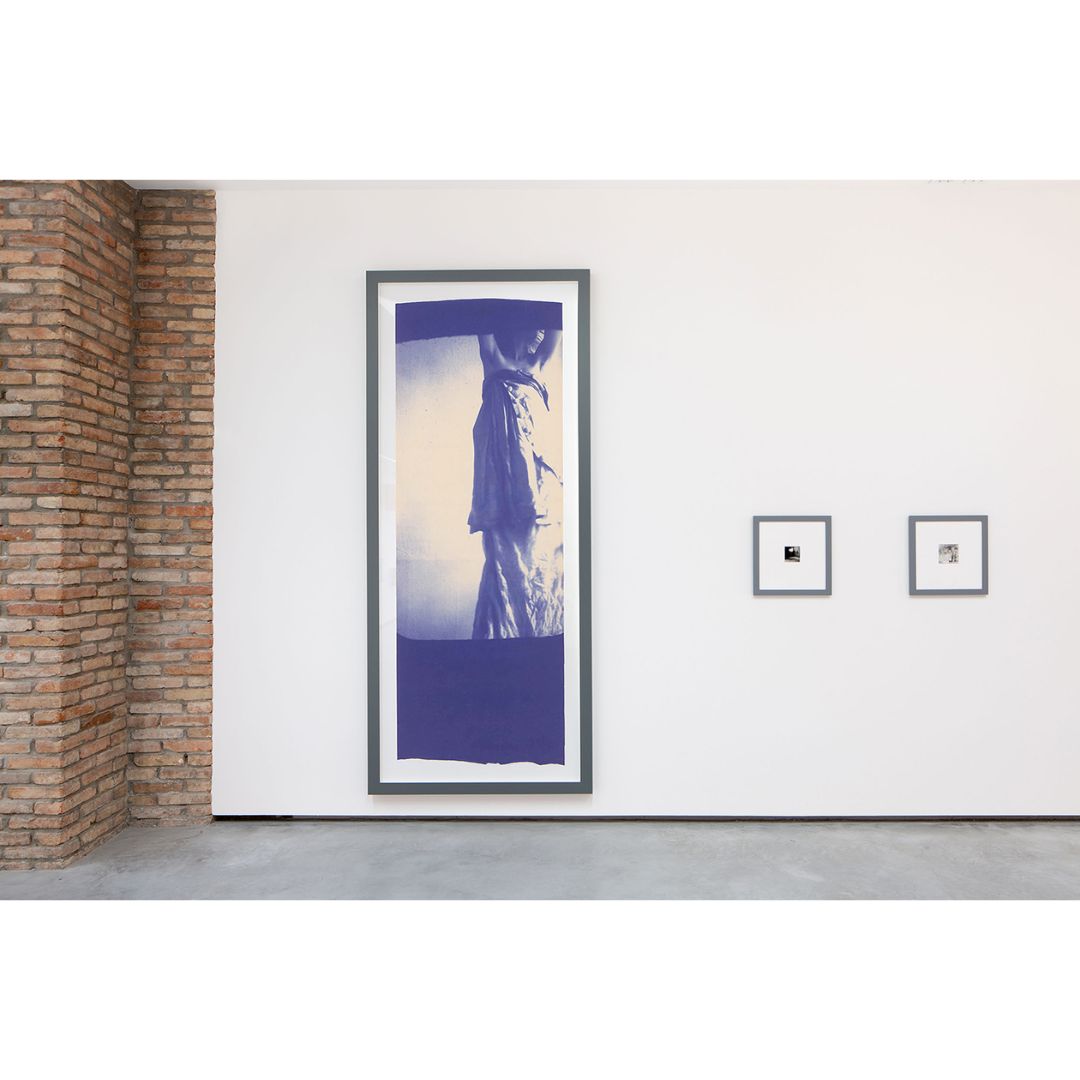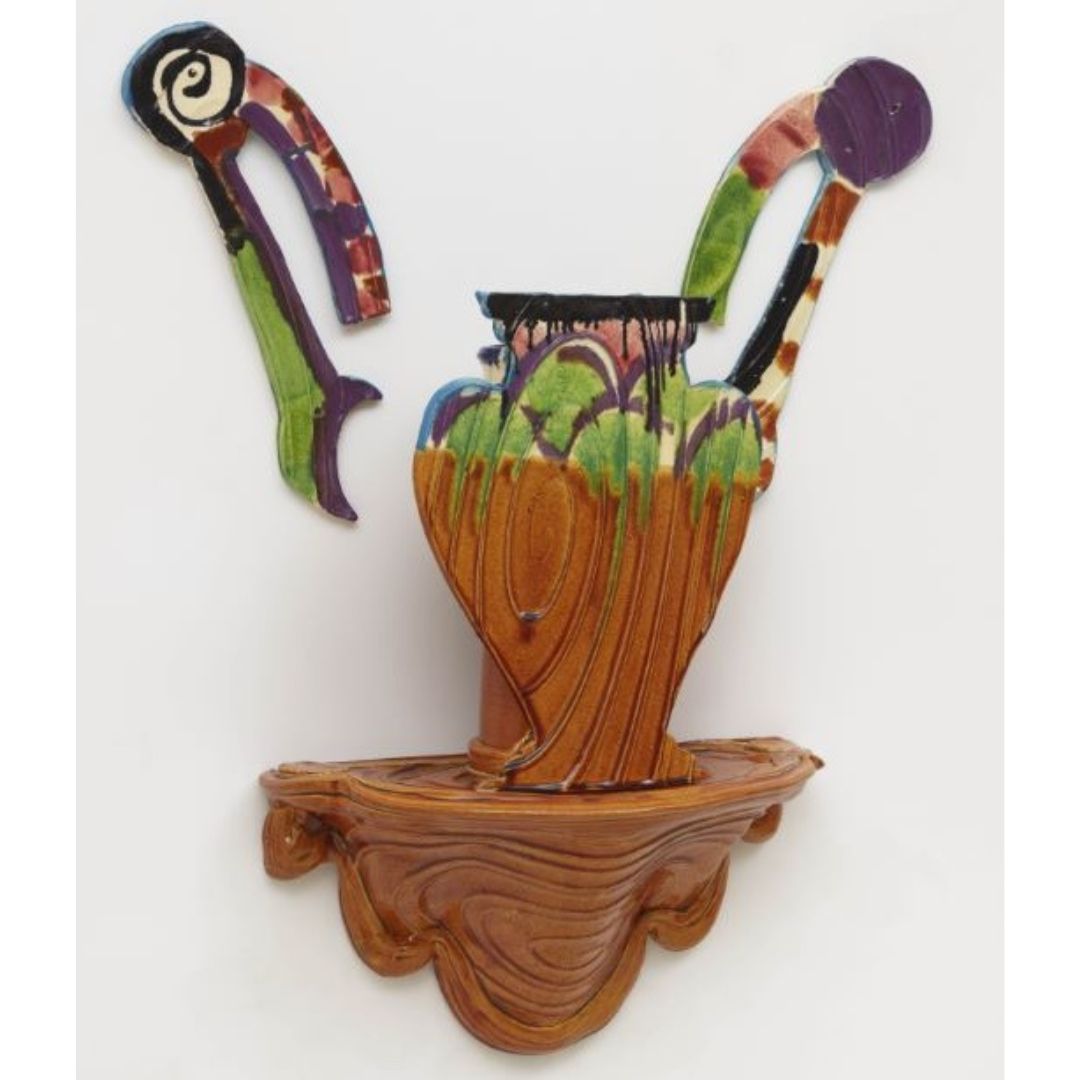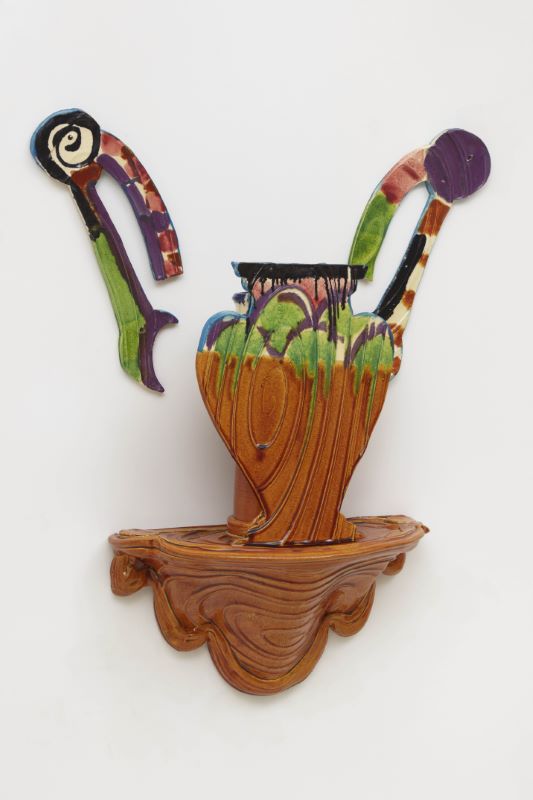L to R: Entrance to the Woodman family’s farmhouse adorned with a Pillow Pitcher by Betty atop a wall of George’s “sgraffito,” 2017 / View of the olive groves from Betty’s studio, 2004 / Betty cutting well-tended roses growing against the wall next to her studio, 2008 / Betty making flower arrangements with roses, dahlias and gerbera daisies from her garden, 2006 / Betty putting fresh flowers in a group of her “Vase and Stand” works, 1984 / Betty, a young family friend, and Francesca, c. late 1960s / Table set for dinner, 2016, photo by Brigid McCaffrey / Generous bowls and baskets full of figs, plums, peaches, grapes, and tomatoes, 2016 / Betty, Charlie and Francesca cooking together, c. early 1970s / George at his studio door, 2006 / A view out from the same door, 2008 / Francesca and Betty holding their bunnies, c. 1968 / Charlie on his motorino, c. late 1960s / Betty and friend with Betty’s triptych “June in Italy” (2001), c. 2001 / George with his sculpture, c. early 1970s / he Woodman family’s patio with potted geraniums and the olive grove in view, c. 1990s / Morning glories climbing George’s “sgrafitto” wall, c. 1990s. Woodman Family Foundation Archives.
L to R: Entrance to the Woodman family’s farmhouse adorned with a Pillow Pitcher by Betty atop a wall of George’s “sgraffito,” 2017. Woodman Family Foundation Archives.
AUGUST IN ANTELLA
Beginning in the summer of 1968, the Woodman Family spent every summer at their stone farmhouse in Antella, Italy, just outside of Florence. As children, Charlie and Francesca joined their parents and later visited on their own, soaking in Italian culture and influences. Betty and George made some of their most important artistic breakthroughs there—a place George once described as "an artist residency for two.” All summer long, their garden produced abundant food and flowers—the tomatoes were particularly good in August, happily shared with frequent visitors.
George Woodman. “Untitled,” c. 1970. 96 x 134 in. Acrylic on canvas © Woodman Family Foundation / Artists Rights Society (ARS), New York
George Woodman, "Untitled," c. 1970
Last week was an exciting one at the Woodman Family Foundation. Upon their long-awaited return to New York, we were treated to a room full of George Woodman’s paintings. And wow we were bowled over by how fresh and contemporary these paintings feel, despite the fact that they were made some 50 years ago. We were struck by the subtle and shifting interplay of color and pattern and the raw intelligence of George's approach, which are slowly revealed over the course of a lingering look. What a pleasure to see these ambitious and original works in person.
All images related to Betty Woodman’s “Bronze Bench #3,” 2003. 57 x 62 x 16 in. Bronze, patina. From L to R: clay models for bronze benches outside Betty’s studio in Antella, Italy / Benches in progress at the Fonderia with Betty’s full-scale drawing / Applying the patina according to Betty’s drawing / The finished bench arrives at Betty’s studio in Antella / Installation view in the courtyard of the Palazzo Pitti, Museo delle Porcellane, Florence, Italy, 2010 / Installation view, “Betty Woodman: In the Garden,” Greenwood Gardens, Short Hills, New Jersey, 2016 / Betty outside of her studio in Antella. Woodman Family Foundation Archives.
Clay models for Betty Woodman's bronze benches outside Betty’s studio in Antella, Italy, c. 2003. Woodman Family Foundation Archives.
Betty Woodman's functional bronze sculptures
On occasion, Betty Woodman translated her abiding interest in the subject of function into materials other than clay, always pushing the possibilities of a particular medium. In 1999, she began an ongoing collaboration with Fonderia Artistica Belfiore in Pietrasanta, Italy, an idea which came from a conversation with her longtime gallerist, Max Protetch and was in part inspired by fellow gallery artist Scott Burton’s sculptural furniture, as well as the formal Italian gardens she had spent decades exploring.
L to R: Installation view, “Low Balustrade Screen” or "Garden Balustrade Screen" (1981) at Haber-Theodore Gallery, New York, 1982 / George Woodman. "Low Balustrade Screen" or "Garden Balustrade Screen," 1981. 151 1/2 x 42 in. Acrylic on canvas, five panels with hinges / Brochure for exhibition “Partitions” at Pratt Manhattan Center Gallery, New York, 1982. Woodman Family Foundation Archives.
Installation view, George Woodman, “Low Balustrade Screen” (1981) at Haber-Theodore Gallery, New York, 1982. Woodman Family Foundation Archives.
George Woodman in "Partitions" at Pratt Manhattan Gallery, New York, 1982
In the fall of 1982, the exhibition “Partitions” at Pratt Manhattan Center Gallery featured the work of 15 artists—including George Woodman—concerned with contemporary interpretations of screens. As hybrid sculptural, decorative, functional objects, partitions and interest in them were a kind of corollary to the burgeoning Pattern and Decoration Movement, and described by critic John Perreault, who wrote the exhibition’s essay, as “ubiquitous,” “a phenomenon,” and “a challenge to some preconceptions about art."
Letter from George Woodman to Francesca Woodman, September 4, 1977. Woodman Family Foundation Archives.
A letter from George Woodman to Francesca Woodman, September 4, 1977
September of 1977 marked the start of new academic year for each of the Woodmans and the pursuit of teaching or studies in four different locations around the US and Europe. Francesca Woodman had just begun her fruitful year in Rome with the RISD European Honors Program, after spending some time in Antella. In a letter sent to her from Boulder, George Woodman recaps summer travels and reports on the rest of the family’s activities.
Francesca Woodman. "Untitled," 1978, 8 3/8 x 8 9/16 in. Gelatin silver print © Woodman Family Foundation / Artists Rights Society (ARS), New York
ON VIEW: Francesca Woodman in “New Time: Art and Feminisms in the 21st Century” at BAMPFA, Berkeley, California, 2021
This ambitious survey of recent feminist practices in contemporary art begins with Lucy Lippard’s observation that feminist art is “a value system, a revolutionary strategy, a way of life.” While the majority of works on view were made in the first two decades of this century, highlighting the wide-ranging concerns and multiple perspectives of contemporary artists, influential works made by artists of earlier generations are also featured, including three photographs by Francesca Woodman.
Envelope for letter from George Woodman in Boulder, Colorado to Francesca Woodman in Rome, Italy, October 19, 1977. Woodman Family Foundation Archives.
Betty Woodman, Francesca Woodman, and George Woodman in “Interior Scroll or What I Did on My Vacation” at S&S Corner Shop, The Art Building, Springs, New York, 2021
We are pleased to announce that this exhibition includes a selection of correspondence written between Betty, Francesca and George Woodman in 1978, as well as Francesca Woodman’s “Selected Video Works,” 1976-1978.
Saul Steinberg show announcement from George Woodman to Betty Woodman, 1952; front and back. Woodman Family Foundation Archives
Saul Steinberg show announcement from George Woodman to Betty Woodman, 1952. Woodman Family Foundation Archives.
Saul Steinberg show announcement from George Woodman to Betty Woodman, 1952
George Woodman and Betty Abrahams wrote each other regularly beginning soon after they met in 1951—while Betty was at home in Newton, MA and later in Fiesole, Italy and George at home in Concord, NH or at school at Harvard in Cambridge, MA—until they married in 1953.
L to R: Installation view, “Rincontrarsi a Venezia,” Spazio Berlendis, Venice, Italy, 2021, including “Untitled,” 1980. 101.93 x 36.62 in. Diazotype / "Self-Deceit #2,” 1978, from the "Self-Deceit" series, 3 9/16 x 3 1/4 in. / “Self-Deceit #7,” 1978, from the "Self-Deceit" series. 3 5/8 x 3 9/16 in. All gelatin silver prints. All works by Francesca Woodman © Woodman Family Foundation / SIAE, Rome
Installation view, “Rincontrarsi a Venezia,” Spazio Berlendis, Venice, Italy, 2021. Artwork by Francesca Woodman © Woodman Family Foundation / SIAE, Rome
Francesca Woodman in “Rincontrarsi a Venezia” at Spazio Berlendis, Venice, Italy, 2021
LAST CHANCE TO SEE Francesca Woodman in Rincontrarsi a Venezia at Spazio Berlendis, Venice, Italy. On view through July 17, 2021.
Betty Woodman. “Shelf and Vase: Zante,” 1985. 31 x 21 x 9 in. Glazed earthenware, epoxy resin, lacquer, acrylic paint © Woodman Family Foundation / Artists Rights Society (ARS), New York
Betty Woodman in “With Pleasure: Pattern and Decoration in American Art 1972-1985” at Hessel Museum of Art, Bard College, Annandale-on-Hudson, New York, 2021
This ambitious exhibition, curated by Anna Katz, brings together American artists, including Betty Woodman, associated with the Pattern and Decoration movement in the first such comprehensive and scholarly survey. The exhibition showcases painting, sculpture, collage, ceramics, installation and performance which embraced craft-based and decorative traditions and approached art-making from a sometimes dizzying appreciation of historic sources and feminist aesthetics.
Family photographs of the Woodman’s sightseeing in Italy, circa 1959-60 and 1965-66. Woodman Family Foundation Archives.
George, Charles and Francesca Woodman in Rome, Italy, 1966. Woodman Family Foundation Archives.
The Woodman family explores Italy, circa 1959-60 and 1965-66
The Woodman family’s lifelong love of Italy began in 1951 with Betty’s yearlong apprenticeship in Fiesole. After marrying in 1953, Betty and George took their young children, Charles and Francesca, for extended stays in 1959-60 and again in 1965-66.
L to R: George Woodman’s exhibition brochure, Boulder Center for the Visual Arts, Boulder, CO, Fall 1981 | Reviews in the Daily Camera and Rocky Mountain News, October 1981. Woodman Family Foundation Archives.
George Woodman’s exhibition brochure, Boulder Center for the Visual Arts, Boulder, Colorado, Fall 1981. Woodman Family Foundation Archives.
George Woodman at the Boulder Center for the Visual Arts, Boulder, Colorado, Fall 1981
George Woodman’s exhibition at the Boulder Center for the Visual Arts in the fall of 1981 was a survey of his various approaches to pattern over 15 years, ranging from his complex tessellations, to the use of pattern to unify a surface, to a rigorous examination of the decorative, and finally to the all-encompassing perceptual experience of his room-scaled paper tile installations.






















